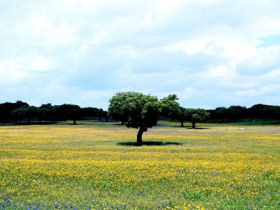Flora and wildlife of Andalusia
Andalusia is typically described, both historically and ecologically as a meeting point between Europe and Africa ; a bridge between two continents, Africa and Europe , and the confluence of the Atlantic and the Mediterranean . The saltier and warmer Mediterranean clashes at Punta de Tarifa, the southernmost point of Europe , with the cold rough waters of the Atlantic producing one of the most biodiverse marine areas in the world.
Some 5,000 vascular plants are to be found, 10% of which are endemic. More than 250 species of birds present throughout the year, including Spanish Imperial Eagle, Glossy Ibis, Spoonbills, White-headed Duck, Crested Coot, making it one of Europe’s best areas for birdwatching. Specifically Doñana is considered as the most important wetland in the whole of Europe , and one of the best birding spots in the whole of the Palaearctic region. Between 300,000 & 400,000 birds winter in Doñana every year and more than 300 species of birds have been recorded here. To the east, t he Sierra de Cazorla is one of the most important biodiversity hotspots in Europe, supporting up to 2,100 plant species of the total of 7,000 recorded for Spain. More to come
External links
Regions of Spain” Andalusia is one of the most attractive areas around the Mediterranean, owing to the good climate and its natural beauty as well as its rich history and culture. But its impressive historic and cultural heritage are outshone by some of the richest natural areas in the Paleartic; a meeting point of Europe and Africa, which still offer breathtaking landscapes and an unusual fauna and flora.” Read Fat birder on Andalusia
Sierra de Baza. Excellent Spanish page on all aspects of nature in the Sierra de Baza. Photos, really good pages on mammals, and one of the best pages on amphibians in whole of Spain
“The spectacular limestone massif of the Sierra de Grazalema (a parque natural of 53,439ha, also a ZEPA and Biosphere Reserve) is one of Andalucía’s prime destinations for nature lovers. Reaching a maximum height of 1,654m (Torreón), Grazalema is the westernmost of the Sierras Béticas, separated from the Atlantic only by a low-lying coastal plain and thus intercepting the lion’s share of the region’s rainfall (some 2,230mm per year)” Read on Wild Spain.
Doñana description (English) from UNEP World Conservation Monitoring Centre
Doñana National Park (World Heritage Site)
Butterflies in Andalusia
Parques Naturales Andaluces (descripition of parks in Spanish)
- Albufera de Adra
- Bahia de Cadiz
- Cabo de Gata-Nijar
- Climate of Andalusia
- Doñana
- Flora and wildlife of Andalusia
- Geography of Andalusia
- Grazalema
- History of Andalucia
- Laguna de Fuente de Piedra
- Las Dehesas de Sierra Morena
- Las Sierras de Cazorla y Segura
- Los Alcornocales
- Nature reserves in Andalusia
- Ordiel Marshes
- Sierra Nevada
- Aiguamolls de l’Empordà Natural Park
- Aigüestortes i Estany de Sant Maurici
- Birding sites in Catalonia
- Cap de Creus
- Catalonia earthquake of 1428
- Congost de Mont-rebei / Mont-rebei gorge
- Delta del Ebro
- Els Ports
- Garraf
- Lake Banyoles
- Lerida Steppes
- Montseny
- Pica d’Estats
- Sant Llorenç del Munt
- Serra de Montsec
- Sierra de Cadi
The Iberianature guide to Spain


 Andalusia with its rugged mountains and stunning scenery offers some of the best hiking in Europe.
Andalusia with its rugged mountains and stunning scenery offers some of the best hiking in Europe.